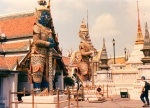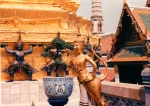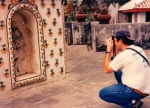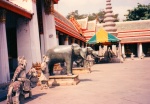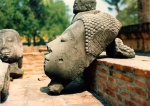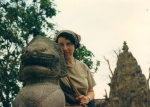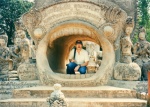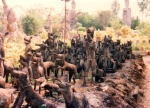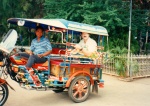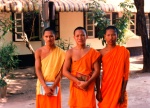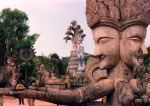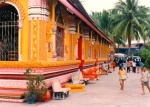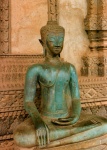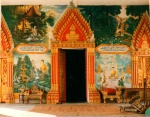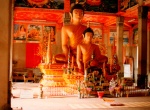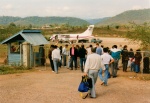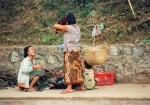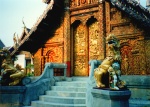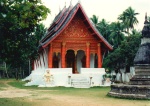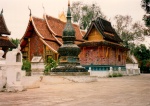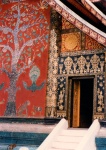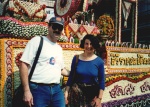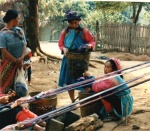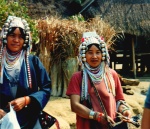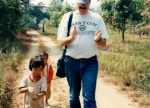We’ve traveled to or through Thailand multiple times. On our first trip in 1994, we spent just a few days in Bangkok, touring the Grand Palace, a few markets, and other sites on our way to Burma. We would have had more time, but Thai Airways decided that we needed to spend more time in Phnom Penh, so they bumped us off our flight.
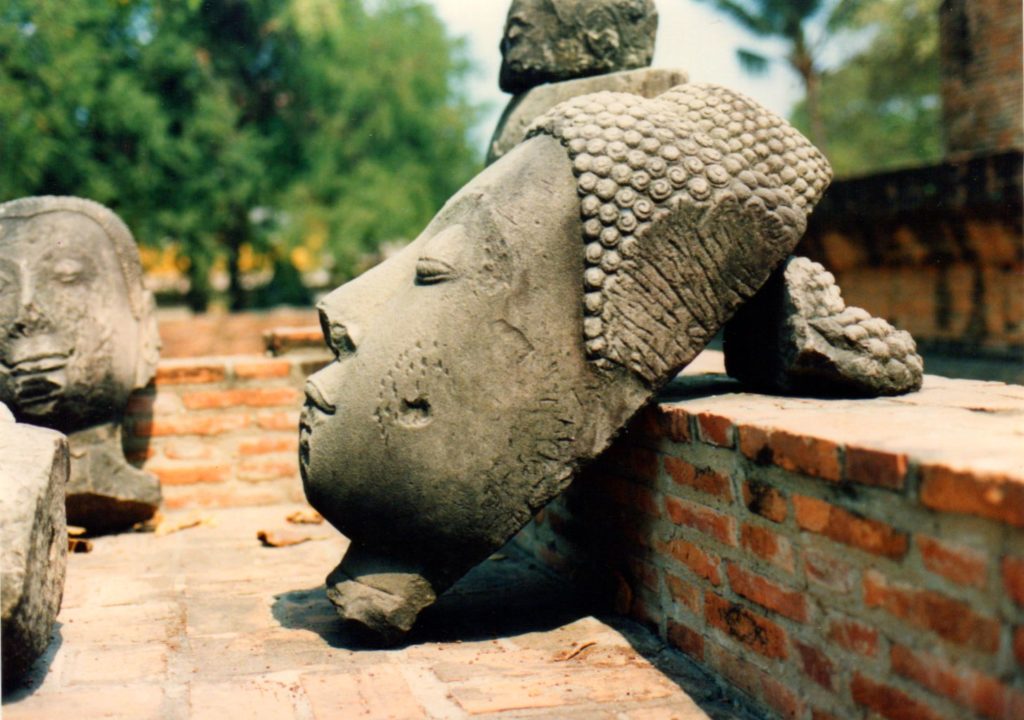
We returned in 1995 to spend two weeks in Thailand plus a few days in Laos.
The flight to Bangkok is long. In fact, it’s so long, that now a Boston-San Francisco flight seems like a short hop – for which it’s not even worth taking off your shoes. Our outbound flight took us through San Francisco, where by some odd coincidence, we bumped into Susan’s mother. We rarely meet people we know while traveling – even at Logan Airport. I suppose the chances of bumping into my mother-in-law is astronomically small, considering that she lives 3000 miles away AND was scheduled to leave for Africa the day before decreased these chances still further. But there she was, on her third iteration of frantically trying to get her bags off one broken airplane and get onto another. She eventually made it, but not without the kind of misery that only airlines seem to be good at.
After an impossibly long day, we arrived in Bangkok – at midnight. At least the airport wouldn’t be crowded, we thought. Quite the contrary. Midnight is rush hour at Bangkok airport. As we left the airport, I glanced at the local English newspaper. In the upper corner, the weather forecast said “cool tomorrow, in the 90s”. We were in deep trouble. We left the too-warm terminal and were hit by the heavy Bangkok hot night air.
These two visits to Thailand were before the construction of the new downtown/airport highway. As a consequence, there was only one tiny road from downtown, infamous for 24/7 traffic jams, and it was completely blocked. On the second trip, we figured out that walking to a hotel would be far faster. We had learned of Don Muang’s Manor, a cheesy but clean and acceptable hotel that is a 10-minute walk from the arrivals terminal. The hotel night guard welcomed us by insisting on spraying the room with some terrible insecticide. Only our repeated and overly firm protests got him to stop.
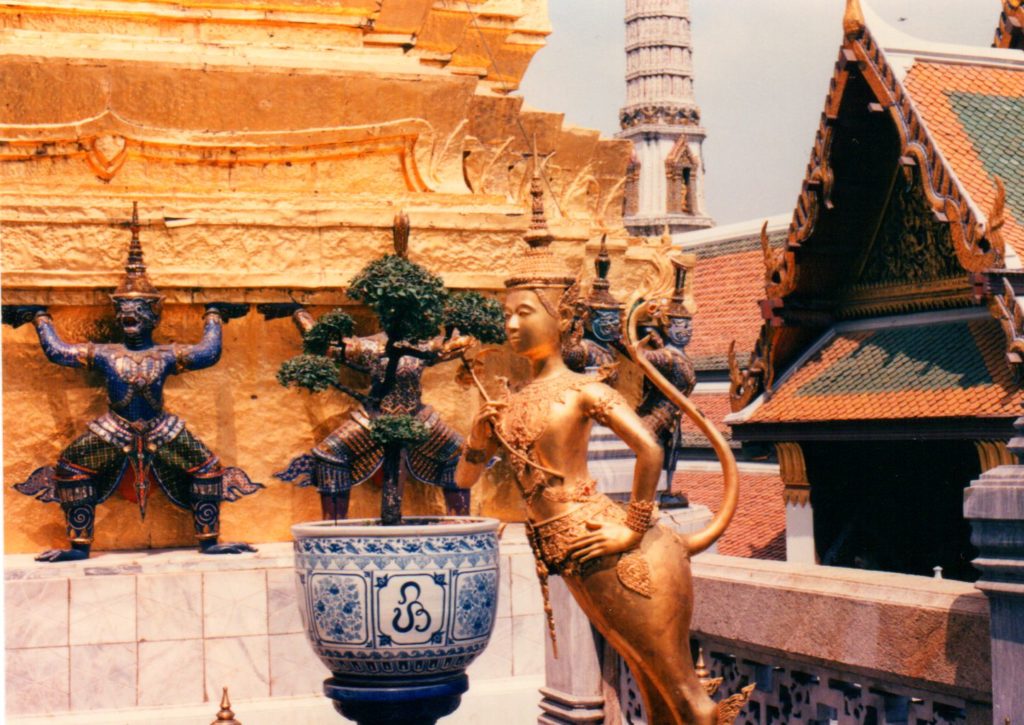
The good part about flying halfway around the planet is that one’s jet lag is so bad that your body actually adjusts very quickly. The fact that most flights land at midnight helps, as we immediately got to our hotel, took our sleeping meds and passed out for 8 hours.
Notable in Thai culture is the very different way that people assert themselves. One never raises their voice. Everything is politely requested. As city-dwelling Americans, we found following this a challenge. On the other hand, the extraordinary politeness is charming and deeply enjoyable. This politeness doesn’t apply to driving, where only the law of the jungle seems to apply. Taxis, trucks, tuktuks, motorcycles all vie for a few precious inches of road space (or sidewalk space). Lane markings are for decoration only.
Bangkok
The next morning, we headed for our new hotel recommended by a travel-writer friend of ours, The Bangkok Christian Guest House. Since we’re Jewish, we hesitated to book here, but we were assured that this was more of a “Y” than a missionary’s facility. In fact, it was perfectly clean, the breakfasts were hearty, and the only evidence of this being a religious-run facility was that one family sitting near us in the cafeteria said grace before eating. The wonderful thing about this hotel was that it was a stone’s throw from Patpong, the red-light district, which has a great night market.
Thailand is also well known for treating foreign women with great respect. Of course, I’m not referring to the tribal and Burmese girls (children, actually) that are sold into indentured servitude, locked up in brothels, and offered to demented male foreigners. People are friendly, respectful, welcoming, and warm. In Patpong, we felt perfectly safe, even at night. That didn’t stop us from wearing travelers’ wallets, but after some of our tougher trips, this level of personal respect instantly charmed us.
It’s fairly easy to get around with English, but since we planned to travel in the countryside a bit, and do this without any assistance of a tour company, Susan volunteered to learn some spoken Thai. This was a tremendous asset, allowing us to use the local and intercity bus system, to haggle, to find things off the beaten path. It also charmed the Thai people – that westerners took the trouble to learn a few words of their language. One of the key phrases that Susan memorized was “not hot” when ordering food. In retrospect, she wished that she had learned “no hot whatsoever, not even a little bit”. Oh well.
The Sites
Thailand is stunningly exotic. Huge temples are painted in bright colors, gates are guarded by massive guard statues. They are all bustling with temple-goers, not tourists like at Notre Dame. Because of the nature (or customs) of Theravada Buddhism, we were welcomed into every temple. (I suggest that you get easy-to-remove shoes.) I won’t detail the Bangkok temples here, except for Wat Arun. The temple itself is modest, but the huge guards make this a truly memorable visit. To get here, you’ll need to take one of the hop-on water taxis, and adventure in itself. Nearby, there are a few open-air riverside eateries.
On our first trip, we visited Bangkok, Burma, and Cambodia, Our itinerary on our second trip took us first to Ayuthaya, then north to Khorat (aka: Nakhon Ratchasima), Nong Khai, into Laos (Vientiane, Luang Probhong), then a flight to Chiang Mai via Bangkok, via bus to Nan, then a bus back to Bangkok.
Ayuthaya
Just north of Bangkok is the Thai empire’s medieval capitol of Ayuthaya, mostly in ruins, and definitely worth visiting. This can be done in a daytrip or an overnight. One word of warning – it’s hotter than hell, and there’s no shade. Doing this as a daytrip may be all but impossible for mere mortals.
With the sun beating down on us (and beating us down), we searched for LP’s recommended hotels. The first one we stopped at, a squalid bug-infested dump was tempting, as it had air conditioning. No… we decided that although vaguely air-conditioned, this was below our minimum standards. Three blocks later, we found our LP’s second recommended hotel, a modern, all-cement super clean place behind a restaurant.
In the middle of the day, we headed out to tour the ruins. Most of the ruins consist of extraordinarily graceful Wats. These are perfectly preserved or restored. They are scattered around the city and are easily accessible.
Statutes of Buddha are typically in one of 6 positions. The most common is the seated position with one hand nested inside the other (Dyhana). However, the most impressive are the reclining statutes, not only because of what it signifies but also because of the size. Reclining Buddhas are huge, some are over 100 feet in length. Often, these huge sculptures are clothed in enormous saffron colored robes. Some of the Ayuthaya’s stupas are the Khmer-style bulging cone, some are the graceful Hershey’s kiss style. Buddhas top almost every structure, Kinaras (angels), garudas (cross between an eagle and other creatures), and other celestial beings abound, and the entire area is awash in extraordinary detail.
We stayed until sunset, taking advantage of the evening’s relative coolness. Twilight on the equator is short; within just a few minutes, it became too dark to see anything.
Substantial restaurants surround the historic areas. We chose one nearby that had ‘karaoke’. We had been seeing karaoke signs everywhere. Perhaps we would be treated to some half-drunk fellow belting out a Thai version of ‘Strangers in the Night?’
We could not possibly have been ready for what we saw. Karaoke does indeed mean singing along with a probably popular song. But that’s not why people go to Karaoke bars. It’s the videos behind the scrolling text. Since showing men with women in videos is apparently prohibited, the videos are, to Western eyes, lesbian porn.
We retreated to our air-conditioned cell and promptly fell asleep, but only for an hour. The restaurant that was in front of the hotel became a disco, with a bass beat that loosened our fillings. We closed the window, turned up the AC, piled all our clothes on top of the blankets and passed out.
We took a train up to Chiang Mai, where we enjoyed the amazing crafts and a two-day flower festival, complete with parades and floats. We booked a guide to take a day trip up to visit some of the surrounding hill tribes. Half way through, he developed a terrible stomach ache, and recruited a group of children about 9-10 years old, to take us to the next village so that he could rest a bit. They were wonderful – not a word of English, but we taught them “The Ants go Marching” and we all clapped together during the 30-minute stroll to the next village. Our guide caught up with us and the entire day was amazing.
Phnom Rung
We made our way northeast. When we were in Bangkok, we had contracted with MK Ways for our Lao visas, a 3-hour tour, accommodations in Vientienne, and internal Lao flights. We had a few days to get there, and planned to go to Phnom Rung.
LP said that the ONLY way to get there was to take two buses and then a motor scooter-taxi. Undaunted, armed with just her 100 words of Thai, Susan successfully negotiated with a taxi driver to pick us up at the hotel at 5:30am and drive us there and back. Phanom Rung is a restored 17th century Khmer city and temple complex. Perhaps one of the Khmer empire’s westernmost establishments, the sharp contrast with the Indian-inspired art of Thailand is striking. The ornamentation and design were almost identical to Angkor.
As we were about to leave, a few loads of very well behaved school kids arrived in a fleet of buses, parking next to a long line of hired taxis. Clearly, the Thai people knew how to get here. We began to realize that the author of the LP book seemed to have missed a few details. One other detail that later became annoying was that LP was very bad at maps. The scale was terrible, the placement of streets was not based on reality, and we would ALWAYS come into town at a different bus station than the book said we would.
Since Susan knew very few words in Thai, we weren’t able to speak with our driver. On the way back, he said something to us very insistently and then veered off the road onto a dirt trail. We theorized that he was taking us to be beaten and robbed. Instead, we were taken to Prasat Muang Tam, an active archaeological site. A French team was excavating the entry area, so we had to walk along narrow planks to enter the site. Designed like a tiny Angkor Wat, this temple complex had some of the most graceful carvings we had seen. This type of “extra” was typical of the Thai people, who are proud of their culture and eager to share it, and we laughed at our initial paranoia.
Nong Khai
On the border of Laos is Nong Khai, a small town with one amazing attraction. Wat Khaek, also known as Buddha Park, is what happens when a monk becomes a gifted hallucinating sculptor. This monk, Luang Pu, has a rather odd artistic, as well an odd sense of scale. The Naga and seated Buddha statues were over 50 feet. Constructed of cement and wire mesh, these huge sculptures seemed to be the product of a drug-induced trance.
We cautiously ate street food, with no ill effects. We generally ate soups from noodle stands. These ubiquitous ‘restaurants’ ranged in size from a stand on wheels (like a dim-sum cart) to a permanent snack bar. In each, we pointed to what we dared eat and tried to make them understand that the longer they boiled it, the better. We were eating noodle soup for breakfast and lunch, and usually going with an LP recommendation for dinner.
Dinners were getting interesting. Susan learned how to say “not hot” while I continually searched for the ultimate fiery experience. “Not Hot” to Thais clearly means ‘not a near-death experience’ as Susan constantly was served stuff that would remove paint.
Wherever we were, we were approached by 14-16 year old monks-in-training. Seeing relatively few farang (foreigners), they tried to practice their English with us. This was usually charming, but they also had the same lesson book, so it got a bit repetitious. “Hello, what is your name, Where are you from. Is this your wife/husband, Do you like Thailand?” We used this as an opportunity to find out what they did, what they thought of Thailand and the world. We were usually approached in groups of 2-3 (up to ten) boys. The ones who were better at English quickly made themselves known.
Crossing the border to Laos
It was less than 25 years ago that the USA bombed the crap out of Laos because ‘we could’. We mercilessly carpet-bombed and defoliated this amazingly beautiful land. US bombers dropped any unused payload on the Plain of Jars, as returning with them was too risky. The fact that the Plain of Jars was in a country that we weren’t at war with didn’t seem to matter. They were commies – so we bombed ‘em. Although we both protested the war, we still felt tremendous guilt in visiting a country that we mistreated. However, the Lao people seemed to be far more at ease over this than we were. We were warmly welcomed everywhere.
Crossing was far simpler than we imagined. We took the bus to the border crossing, walked across the Friendship Bridge, had our passports stamped, and were greeted by our MK Ways driver.
Our fist task was to confirm our flight from Vientienne to Bangkok. We sought out the Lao airways office – a tiny office a few blocks from the city center. There was only one fellow present in the office. This was in the capital city of Laos – and this was their national airline. He got out the notebook, turned to a dated but otherwise blank page and carefully wrote down our names. Our reservations were now confirmed.
Vientienne is a very spread-out city, built by the French, and still has “colonial charm”. They still sell French baguettes. The tailor shop was named ‘Levy Tailor’. The market was filled with an incredible number of people from hill tribes in their traditional attire. We also went to the second park created by Luang Pu, and it confirmed our theory that he used psychedelics.
We continued (by plane) on to Luang Prabang. This small city is located on the Mekong River. Noted for its graceful architecture and limestone caverns, we spent several days wandering around the beautiful temples. To our surprise we ran into one of the American guides who’d led our trip to Burma in 1994! We met that night at a small restaurant, where we had the unbelievable experience of watching carefully separated lines of men and women, in traditional garb, doing line dances to “Achy Breaky Heart”. Small world…
The craftsmanship on the temples was just amazing – wood carved, often covered with gold leaf. In one market we found a small table with legs shaped like elephants. We had to have it, and fortunately the top was removable and the legs folded. We left Luang Prabang with heavier luggage, but happy.
